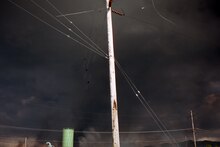Olympic Pipeline Explosion
Background

Olympic Pipe Line Company ran a network of fuel pipes beginning at refineries in Whatcom County and Anacortes and running south to Seattle and Portland. In 1999, the pipeline was owned and operated by Equilon, a joint venture between Shell Oil and Texaco. As of 2006, the pipeline is 65% owned by Enbridge and 35% owned by BP.


Disaster
The disaster began as Olympic Pipeline was transporting gasoline from Cherry Point Refinery to terminals in Seattle and Portland, Oregon. A pressure relief valve that was improperly configured failed to open in the 16-inch (410 mm) pipeline, which resulted in a surge of pressure after an automatic valve shut for unknown reasons. This resulted in the line rupturing at 3:25 that afternoon, and gasoline began spilling into Hanna Creek just above its confluence with Whatcom Creek. As the gasoline continued to spill, many people in the area called 911 to report the gasoline smell, and an Olympic Pipeline employee who was in the area called the company to inquire whether they had an anomaly.
When the Bellingham Fire Department arrived, massive amounts of gasoline had turned the creek pink, and the fumes were overwhelming. The fire department notified Olympic Pipeline of the leak and evacuated the area around the creek.
The gasoline exploded at 5:02 PM. The black smoke plume extended to an altitude of 30,000 feet (9,100 m) and the smoke from the explosion was visible from Vancouver to Anacortes. The fire exceeded 2,000 °F (1,090 °C). Local businesses were evacuated, Interstate 5 was closed to traffic, and the Coast Guard stopped maritime traffic in Bellingham Bay in anticipation of the fire travelling the entire length of the creek. However, the fire never extended past Interstate 5.
Emergency responders stopped most of the fires by 6:30 PM; the smoke dissipated by 7:00.
Victims
Three people died in the incident. The first was Liam Wood, 18, who was fly fishing in the creek. He was rendered unconscious by the fumes and fell into the creek, drowning before the explosion. Two children, Wade King and Stephen Tsiorvas, both 10, were playing near the creek confluence during the explosion. Both survived the blast, but sustained severe burns, dying the next day at Harborview Medical Center in Seattle. There were eight related injuries. Wade King's parents donated $400,000 to the Bellingham School District, and in 2007 Wade King Elementary School was named in memory of Wade King.
Damage
Property damage was estimated at $58,455,927, most of it caused by the explosion. Many nearby buildings had broken windows. One house was completely destroyed. The city's water treatment plant was near the explosion site, and while the building itself survived, everything inside was destroyed. The rupture allowed 277,000 US gallons (1,050,000 L) of gasoline to escape into the creek bed. Bellingham water treatment personnel were forced to manually add water treatment chemicals to keep the water supply safe until the plant could be rebuilt.
Authorities all noted that the destruction and death toll were much lower than would be expected from such a large explosion. This was due to the explosion being centered in a large, forested park; the fires mostly staying in Whatcom Creek; and the ignition occurring before more gasoline had leaked, which would have resulted in a much larger explosion. The cause of ignition was determined by Bellingham Fire Dept to be a butane lighter in the possession of King and Tsiorvas.
Investigation
After a three-year investigation, investigators pointed to a series of failures, and not just a single error, most of which were the fault of Olympic Pipeline. Olympic Pipeline had failed to properly train employees and had to contend with a faulty computer SCADA system and pressure relief valve. In 1994, five years before the accident, an IMCO Construction crew, working on behalf of the City of Bellingham, damaged the pipeline while constructing the city's water treatment plant and failed to notify officials about the damage. Subsequently, Olympic Pipeline failed to find or repair the damage.
Olympic, Equilon and several employees faced a seven-count indictment after the investigation in 2002. The companies pleaded guilty to several of the charges, leading to a $112 million settlement, a record at the time. This was the first conviction against a pipeline company under the 1979 Hazardous Liquid Pipeline Safety Act.
Recovery

The Whatcom Falls Park in 2020 describes much of the area around the creek as "sensitive due to hazardous trees and for forest recovery from 1999 pipeline explosion."

Bibliography
- Notes
- ^ Archived at Ghostarchive and the Wayback Machine: Disaster Bellingham. YouTube.
- ^ McClary 2003
- ^ BPpipelines 2000
- ^ National Transportation Safety Board (8 October 2002). "Pipeline Rupture and Subsequent Fire in Bellingham, Washington, June 10, 1999" (PDF). ntsb.gov. Washington, DC. Retrieved 22 June 2022. (Pipeline Accident Report NTSB/PAR-02/02.)
- ^ Millage 2009
- ^ Watts 2009
- ^ Gaard 2007, p. 48
- ^ "Construction to Begin on New Wade King Elementary School". Bellingham Public Schools. Retrieved 2023-07-17.
- ^ Washington Military Department – Emergency Management Division 2013
- ^ "Whatcom Falls Trail Map" (PDF). cob.org. Retrieved 14 November 2020.
- References
- McClary, Daryl C. McClary (June 11, 2003). "Olympic Pipe Line accident in Bellingham kills three youths on June 10, 1999". historylink.org. Retrieved March 24, 2013.
- "2000: BP Pipelines Operates Olympic Pipe Line". BP p.l.c. Retrieved March 23, 2013.
- Millage, Kira (June 7, 2009). "Timeline of Bellingham pipeline explosion". The Bellingham Herald. Archived from the original on January 17, 2013. Retrieved March 24, 2013.
- Watts, John. "A Decade of Healing". Pipeline Safety Trust. Retrieved March 23, 2013.
- Gaard, Greta Claire (2007). The Nature of Home: Taking Root in a Place (2007 ed.). University of Arizona Press. ISBN 9780816525768. - Total pages: 213
- Washington Military Department – Emergency Management Division (2013). "Local Hazard – Pipeline". Washington Military Department – Emergency Management Division. Retrieved March 24, 2013.
- "Incident on June 10, 1999". ProPublica. Retrieved 2019-07-22.